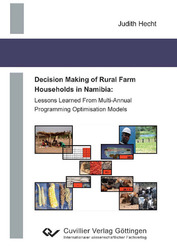| Areas | |
|---|---|
| Serie de libros (96) |
1378
|
| Nachhaltigkeit |
3
|
| Gesundheitswesen |
1
|
| Letra |
2363
|
| Ciencias Naturales |
5406
|
| Matemática | 229 |
| Informática | 319 |
| Física | 980 |
| Química | 1363 |
| Geociencias | 131 |
| Medicina humana | 243 |
| Estomatología | 10 |
| Veterinaria | 108 |
| Farmacia | 147 |
| Biología | 835 |
| Bioquímica, biología molecular, tecnología genética | 121 |
| Biofísica | 25 |
| Nutrición | 45 |
| Agricultura | 1004 |
| Silvicultura | 201 |
| Horticultura | 20 |
| Ecología y conservación de la tierra | 148 |
| Ciencias Ingeniería |
1791
|
| General |
97
|
|
Leitlinien Unfallchirurgie
5. Auflage bestellen |
|
Erweiterte Suche
Decision Making of Rural Farm Households in Namibia: Lessons Learned From Multi-Annual Programming Optimisation Models (Tienda española)
Judith Hecht (Autor)Previo
Indice, Datei (50 KB)
Lectura de prueba, Datei (130 KB)
Farming activities are one of several driving forces which lead to continuous deterioration processes of tree and bush savannahs in the Kavango Region of North-eastern Namibia. However, these activities are closely connected with securing subsistence needs of farm households (peasant farmers). Though the number of undernourished people declined in Namibia, a considerable portion of the population is still affected by malnutrition today. In this context the present study aims to assess long-term effects of farm household strategies on deterioration processes and food security by identifying a) objectives of farm households, b) their most prevailing on-farm and off-farm activities, c) optimal farm household strategies and d) policy-induced changes. These objectives are tackled by developing a multi-annual programming optimisation model of a typical village that includes relevant bio-physical features. This model is theoretically based on the farm household model of Barnum and Squire. However, it is supplemented by features from Chayanov and Low. As a second theoretical pillar the model considers aspects of bio-economics in order to reflect economic and environmental dynamics. Semi-structured interviews and a traditional conjoint-analysis served as data collection exercises for different model parameters. Generally, results of the modelling approach indicate that a) optimal farm household strategies include a high diversity of activities and b) farm households are highly attracted by activities with a low labour demand. Obviously, family labour is one of the most prominent limiting factors. Since this factor might be threatened by several socioeconomic developments in the future, it seems to be of high relevance to a) promote labour-saving activities and b) support the use of labour-saving devices.
| ISBN-10 (Impresion) | 386955505X |
| ISBN-13 (Impresion) | 9783869555058 |
| ISBN-13 (E-Book) | 9783736935051 |
| Idioma | Inglés |
| Numero de paginas | 272 |
| Edicion | 1 Aufl. |
| Volumen | 0 |
| Lugar de publicacion | Göttingen |
| Lugar de la disertacion | Universität Giessen |
| Fecha de publicacion | 09.11.2010 |
| Clasificacion simple | Tesis doctoral |
| Area |
Agricultura
|








